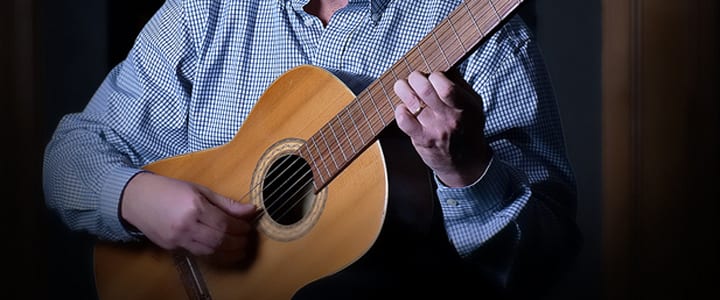 Whether you’re brand new to guitar, or just new to classical guitar, you might be wondering, “what’s the deal with tabs and sheet music?” Let guitar teacher Raymond L. clear up the fog and put you on the right path to classical guitar success…
Whether you’re brand new to guitar, or just new to classical guitar, you might be wondering, “what’s the deal with tabs and sheet music?” Let guitar teacher Raymond L. clear up the fog and put you on the right path to classical guitar success…
To get started, let’s be sure to clearly distinguish standard musical notation from what we call nowadays “tab” notation.
What is Tab?
The name tab, or guitar tab, is derived from tablature, a form of musical notation indicating fingering and frets of fretted stringed instruments such as the guitar.
Tabs have 6 lines which represent the 6 strings of the guitar. It is commonly used in notating rock, pop, folk, ragtime, bluegrass, and blues music and is mostly related to the acoustic and electric guitar.
Tab is not that popular for classical guitar, even though there are some “serious” music pieces transcribed for classical guitar using tabs.
What is Standard Musical Notation?
The standard musical notation for guitar uses staffs of five horizontal parallel lines where symbols are notated to represent musical expressions. In the example below, the top line is standard musical notation, and the bottom is written in tab.

Should I Learn to Read Standard Notation or Can I Use Classical Guitar Tabs?
To answer the above question you should ask yourself first: Do I want to study classical guitar and start a career, or do I want to play guitar just as an amateur?
Not to learn standard musical notation being a dedicated classical guitar student, who wants to pursue a career in classical guitar performance, is potentially limiting because there is so much more information in standard notation than there is in tab notation.
Even though there is no such a rule that says that it is imperative that an amateur or even a professional must learn standard notation, you, as a serious classical guitar student, will want to access the existing information in order to achieve the utmost technical & musical development contained in standard notation.
There have been various attempts trying to incorporate all this information in a Tab notation but they are generally quite cluttered and difficult to read.
Also the best existing method books used to teach classical guitar are, as of this day, written in standard notation, such as Arenas, Solo Playing Guitar, and Melodic Guitar, just to mention a few.
Other limitations of “contemporary” tab notation vs standard musical notation are:
- It doesn’t tell you how long to play the notes, making it hard to recognize or understand the musical piece
- It doesn’t allow you to choose where to play in order to reach various color-tone nuances
- It doesn’t support understanding of music theory per example: chords, keys, etc.
- The options are, as far as classical guitar repertoire is concerned, most limited
- It doesn’t achieve accuracy compared to standard musical notation
Why would you want to study the classical guitar without learning the literary skills of standard musical notation, which are inherent to it? It is important to study the classical guitar by traditional standard music notation! It might take some effort to learn to read music, but in the long run it’s worth it.
 Raymond L. teaches guitar, classical guitar, musical theory, ukulele, and Spanish in Jacksonville, FL. Raymond has been teaching for over 30 years and he specializes in pop, blues, modern, Latin, classical and popular music. Learn more about Raymond.
Raymond L. teaches guitar, classical guitar, musical theory, ukulele, and Spanish in Jacksonville, FL. Raymond has been teaching for over 30 years and he specializes in pop, blues, modern, Latin, classical and popular music. Learn more about Raymond.
Photo by Charles Knowles
Megan L.

